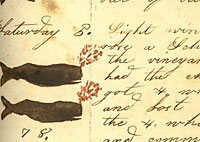
Lesson 2
Researching Primary Sources
- Time Required: 90 minutes
- Curriculum Fits: History, English/Language Arts, Technology
Lesson Overview
In this lesson students will review the differences between primary and secondary sources discussing in which circumstances each type of source would be desirable. Using a list of websites provided by the teacher as well as others they find, students will conduct their research online, searching for both primary and secondary source materials.
Learning Objectives
- Students will deepen their understanding of the difference between primary and secondary sources and the relative strengths and limitations of each.
- Students will analyze and evaluate the usefulness of research findings, applying knowledge they have gained about primary and secondary sources.
- Students will become familiar with websites and other resources that are useful in locating primary and secondary sources.
- Students will practice procedures for documenting research sources.
Materials
- student textbook: The American Vision
- ESL student textbook: America’s Story
- book: Charles Banks’ History of Martha’s Vineyard
- student worksheet: Source Form
- copies of 1855 Letter from Susan to Peter Cromwell (artifact collection)
- copies of examples of primary sources to use for demonstration/discussion
- computer access for student use
- writing materials
Procedure
- As the students come in, ask them to jot down one reaction they had to the homework assignment. At the beginning of class guide a discussion about those reactions. How easy or difficult was it for them to find relevant information? What kinds of information were they able to find? Where did it come from? Let them know that a little later in class they will return to the question of where to find relevant research sources.
- Ask students to share what they know about primary and secondary sources. Clarify any misperceptions and either provide or generate a working definition for each. Using examples of primary and secondary sources, have the students compare and contrast the strengths and limitations of each and discuss circumstances in which one or the other might be more desirable.
- Have the students brainstorm Internet sources for primary sources
in digital format. Provide a supplemental list of websites that
may be particularly useful for this research project, including
the following:
- Martha's Vineyard Museum (http://www.mvmuseum.org/)
- Laura Jernegan: Girl on a Whaleship (http://www.girlonawhaleship.org/)
- Plucky Letters to US Soldiers in Iraq (http://letters2iraq.blogspot.com/)
- Time Magazine Article: The Secret Letter From Iraq (http://www.time.com/time/world/article/0,8599,1543658,00.html)
- Boots On Ground (http://www.bootsonground.com/iraq-communications.htm)
- Explain the importance of source documentation in research. Handout copies of the Source Form with instructions on how to complete it.
- Give students class time in their research groups to search for primary and secondary sources. Ask them the fill out Source Forms for each one they find, either taking notes or printing out the information they gather.
- At the end of the work period, ask groups to look over the information they’ve gathered so far, assessing how they are doing and what they still need to do. Have the note taker in each group record this in a log entry.
Assessment
Before leaving class, ask each student to submit an “exit ticket” with three pieces of information they have learned today, either about research in general or about their specific topic.
Homework Assignment
Write a two-page journal entry about the group’s work thus far, including one piece of interesting information they have uncovered, explaining why it is important to the research.